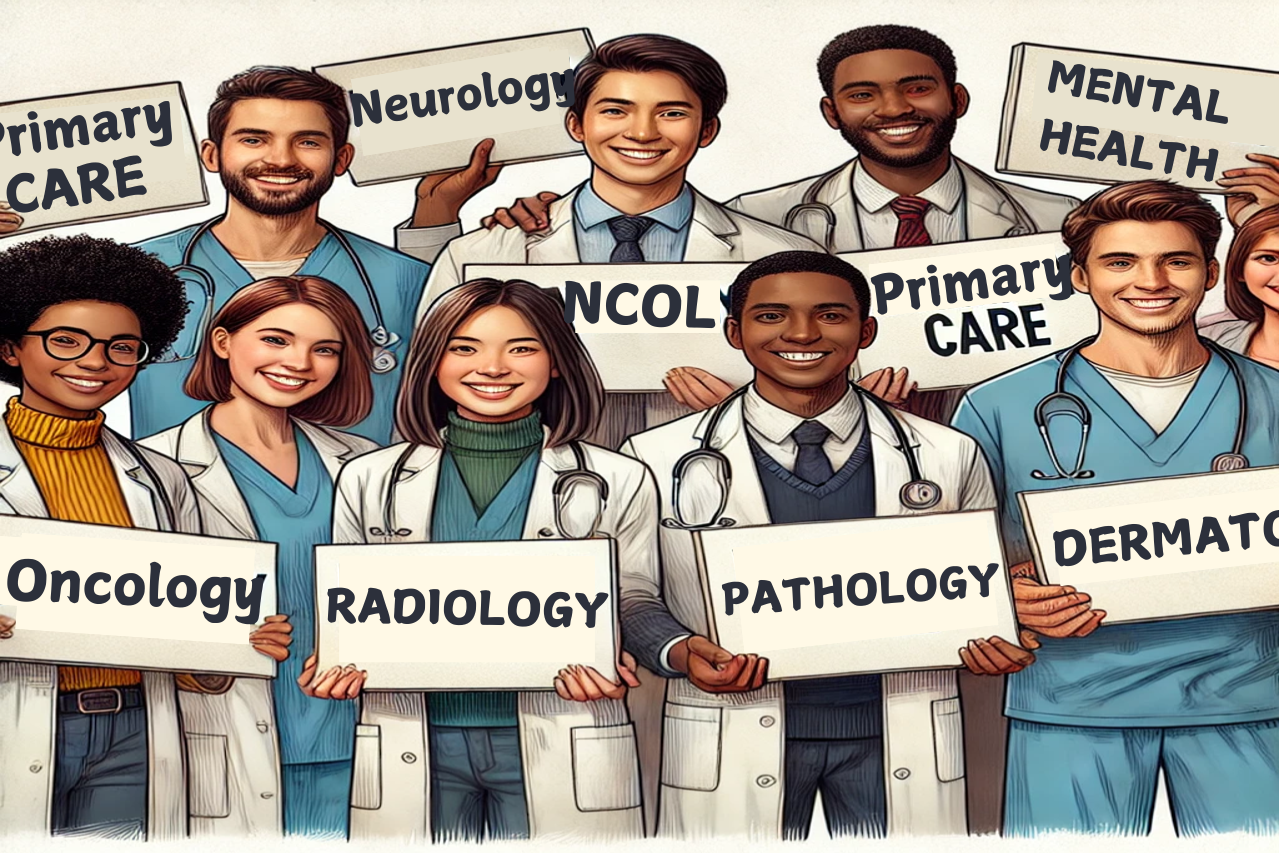The rapid integration of artificial intelligence (AI) into healthcare is reshaping nearly every medical specialty, creating new opportunities and challenges for aspiring physicians. AI’s capabilities—from advanced diagnostics and predictive analytics to personalized treatment planning—have ushered in an era where the role of doctors is transforming. For medical students pondering which specialty to pursue, selecting a medical specialty involves more than just a passion for a particular field. understanding how AI is likely to impact each field is essential.
Preparing for an AI-Enhanced Medical Career
For medical students, the prospect of AI-enhanced specialties offers both excitement and challenges. Steps to ensure a successful career:
- Embrace Lifelong Learning: AI in healthcare is continuously evolving, so it’s essential to stay updated with the latest developments.
- Develop Data Literacy: Understanding data analytics and machine learning concepts will give you a competitive edge. Many medical schools now offer courses on AI and data science—consider taking them.
- Focus on Ethical AI: AI raises ethical issues, particularly around data privacy and patient consent. Familiarize yourself with AI ethics to ensure patient-centric and ethical practices.
- Choose Your Specialty Wisely: Consider how AI will shape your field of interest. Each specialty has unique opportunities and challenges in an AI-enhanced future.
- Get Hands-On Experience: Participate in internships, research, or projects involving AI in healthcare. Real-world experience will prepare you to integrate AI into your future practice.
Radiology: AI-Powered Diagnostics and Image Analysis
Radiology has been at the forefront of AI integration due to the field’s reliance on imaging, which AI excels at analyzing. Machine learning algorithms can rapidly process images to detect abnormalities—sometimes with greater sensitivity than human radiologists. For instance, AI is used in breast cancer screening to analyze mammograms and identify potential malignancies with high accuracy. AI in radiology is projected to grow significantly, with the global market for AI-driven imaging reaching an estimated $2 billion by 2025, up from $800 million in 2022, according to Grand View Research.
Impact on Radiologists: AI will likely handle routine image analysis, allowing radiologists to focus on complex cases and interventional radiology. While there were initial concerns about AI replacing radiologists, the consensus is that AI serves as a tool to enhance accuracy and efficiency. Radiology is a trailblazer in AI adoption, particularly in image analysis for conditions like lung cancer, fractures, and brain hemorrhages. For example, the FDA-approved AI tool “Viz.ai” detects large vessel occlusions in stroke patients, enabling faster interventions (source: FDA).
Skills Needed: Future radiologists should focus on acquiring skills in AI model interpretation, data analytics, and familiarity with specific radiology AI platforms. Resource: The American College of Radiology offers courses on AI in medical imaging, and platforms like Coursera provide foundational AI and data science courses.
Pathology: Revolutionizing Disease Detection and Digital Workflow
Pathology is also undergoing significant changes with AI, particularly in digital pathology, where AI systems analyze histopathological images to identify disease markers. AI models can quickly detect patterns and anomalies in tissue samples, enabling faster diagnosis of diseases like cancer.
The digital pathology market, which includes AI applications, is expected to grow at a CAGR of 12.1% from 2022 to 2030 (source: Allied Market Research), largely due to AI’s role in automating tissue sample analysis and detecting disease markers with high precision. For instance, PathAI’s platform has been implemented in several hospitals, aiding pathologists in detecting cancerous cells faster and with improved accuracy (source: PathAI).
Impact on Pathologists: AI will handle much of the routine analysis, but pathologists will continue to play a crucial role in interpreting results and making complex diagnostic decisions. AI can support pathology by reducing human error and accelerating diagnostic workflows.
Skills Needed: Aspiring pathologists should develop skills in digital pathology software and understand AI-assisted diagnostic tools. A background in digital pathology and machine learning will be advantageous. Pathologists should also focus on honing their diagnostic interpretation skills, as human expertise remains irreplaceable for complex cases. Resource: The Digital Pathology Association offers resources and training for AI integration into pathology practices.
Dermatology: Skin Disease Screening and Virtual Assessments
AI in dermatology is a booming field, with an expected growth rate of 25% annually from 2023-2030 (source: Allied Market Research), fueled by AI’s ability to analyze skin images for early disease detection. AI is being used to analyze skin images for signs of conditions like melanoma, psoriasis, and eczema. AI-powered apps allow patients to take pictures of their skin and receive preliminary assessments. These tools enable dermatologists to manage more patients and reduce delays in diagnosing skin conditions.
Impact on Dermatologists: Dermatologists will benefit from AI’s ability to perform initial screenings and triage patients. However, they will still be crucial for definitive diagnoses and treatments.
Skills Needed: Dermatologists should be knowledgeable in digital dermatology tools and learn to interpret AI outputs. Familiarity with patient data privacy will be essential, especially for telemedicine applications.
Oncology: Personalized Treatments and Predictive Analytics
AI’s market impact in oncology is expanding rapidly, with an estimated CAGR of 30% between 2023 and 2030 (source: Fortune Business Insights), as oncology is experiencing an AI-driven shift toward personalized medicine. AI is being used to predict patient outcomes, tailor treatments to genetic profiles, and analyze data from clinical trials to identify promising therapies. For example, AI algorithms can predict tumor responses to different treatments, enabling oncologists to customize therapy based on individual patient profiles.
Impact on Oncology: AI enables oncologists to tailor treatments by analyzing genetic profiles and clinical data. IBM’s Watson for Oncology is an example, as it provides evidence-based recommendations, helping oncologists make personalized treatment decisions faster (source: IBM).
Skills Needed: Oncologists should be well-versed in bioinformatics, predictive modeling, and genomics. Resource: The American Society of Clinical Oncology offers resources on AI’s application in oncology.
Primary Care: Preventive Care and Chronic Disease Management
AI’s role in primary care focuses on prevention and chronic disease management. The use of AI in primary care is projected to grow, especially for managing chronic diseases, with a CAGR of 23.5% from 2022 to 2030 (source: MarketsandMarkets). Predictive analytics allow primary care physicians (PCPs) to identify patients at high risk of developing conditions such as diabetes and hypertension. AI is also helping PCPs manage patients with chronic diseases through remote monitoring tools.
Impact on PCPs: AI will make preventive care and patient management more efficient. PCPs will need to interpret AI-driven insights and help patients understand their health risks and options. AI-based tools like Babylon Health’s symptom checker help primary care physicians manage patient queries, triage cases, and monitor chronic illnesses efficiently (source: Babylon Health).
Skills Needed: A background in population health and chronic disease management will be helpful. PCPs should also be comfortable with wearable technology and remote monitoring tools to manage patient health data. Resources: Primary care physicians should focus on skills in population health analytics and chronic disease management. Harvard’s Primary Care Program includes training modules on AI and population health.
Psychiatry: Mental Health Prediction and Virtual Therapy
AI is being used in psychiatry to identify mental health patterns, predict crises, and even provide therapeutic interactions via chatbots. Machine learning models can analyze behavioral data, social media activity, and language patterns to assess mental health risks and provide support.
Impact on Psychiatrists: AI will aid psychiatrists by identifying at-risk individuals and providing data-driven insights. However, human interaction remains vital in psychiatry, and AI’s role will be more supportive than primary.
Skills Needed: Psychiatrists should understand AI-based diagnostic tools and be skilled in virtual patient interactions. Familiarity with digital health ethics and patient privacy laws is crucial due to the sensitive nature of mental health data. Advocate for Ethical AI: As future healthcare professionals, students have a role in promoting the ethical use of AI in mental health, ensuring it’s accessible, effective, and respectful of privacy.
Neurology: AI in Brain Imaging and Predictive Analysis
Neurology is a rapidly evolving field, thanks to AI’s ability to analyze complex brain imaging data and provide insights that were previously impossible to obtain. In neurology, AI is used to detect early signs of neurodegenerative diseases like Alzheimer’s and Parkinson’s, predict disease progression, and assist in mapping brain functions for surgical planning. AI-powered diagnostic tools, predictive analytics, and data-rich brain imaging insights offer neurology a precision-based approach that is transforming patient care.
Impact on Neurologists:
AI provides neurologists with data-driven insights that enhance their ability to diagnose, monitor, and predict neurological conditions. With access to AI-enhanced imaging and predictive tools, neurologists can identify disease markers early and customize treatment plans based on predictive modeling. However, the role of neurologists remains essential in interpreting AI outputs, as each patient’s unique clinical profile demands nuanced understanding beyond AI’s generalized predictions. AI in neurology thus offers enhanced support but requires critical interpretation and patient-centered analysis.
Skills Needed:
For those considering neurology as a specialty, expertise in brain imaging, predictive modeling, and AI-based diagnostics will be increasingly valuable. Knowledge in neuroinformatics—where data from brain research and clinical records are combined for deeper insights—will also be beneficial. Medical students should look for opportunities to develop skills in imaging techniques like MRI and EEG, as well as experience with AI diagnostic software.
Each of these specialties demonstrates the profound impact of AI on healthcare. For medical students, choosing the right specialty now includes considering how AI will shape the field and what skills will be essential for success. Developing expertise in both your chosen specialty and AI-related technologies will set you up for a future-proof career in an AI-enhanced healthcare system.
Are you interested in how AI is changing healthcare? Subscribe to our newsletter, “PulsePoint,” for updates, insights, and trends on AI innovations in healthcare.




